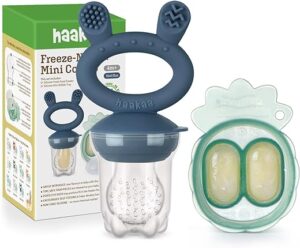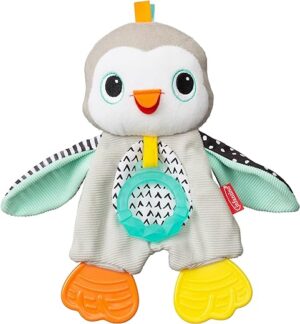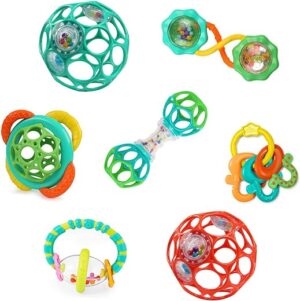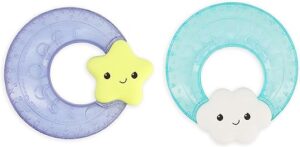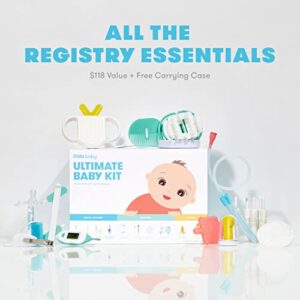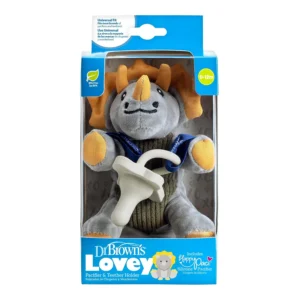Teething is a natural process that every baby goes through. It is when the baby’s first teeth start to emerge through the gums. While it is an exciting milestone for parents, it can also be a challenging time for babies. Teething can cause discomfort, pain, and irritability in babies, making them fussy and difficult to manage. It is important for parents to understand how to help their babies through this phase and to provide them with the necessary tools to ease their discomfort.
In this blog post, we will discuss the teething process, symptoms, and how to provide relief for your baby. We will also highlight the importance of using baby teethers and soothers, as well as any health recommendations for parents.
- The Teething Process
- Symptoms of Teething
- Relief for Teething Babies
- Importance of Baby Teethers and Soothers
The Teething Process
Teething usually begins between 4 to 7 months of age, although some babies may start earlier or later. The first teeth to emerge are usually the lower front teeth, followed by the upper front teeth. By the age of 3, most babies will have a full set of 20 primary teeth.
During the teething process, the baby’s gums may appear swollen and red. They may also be more sensitive to touch, and babies may experience discomfort and pain. Teething can also cause babies to drool excessively and may result in a rash around the mouth area. Babies may also experience changes in their eating and sleeping patterns.
Symptoms of Teething
Symptoms of teething may vary from baby to baby, but some common symptoms include:
- Drooling
- Irritability and fussiness
- Biting or chewing on objects
- Swollen and red gums
- Sleeping difficulties
- Changes in eating patterns
- Ear pulling or rubbing
- A slight increase in temperature
Relief for Teething Babies
While there is no guaranteed way to make teething pain go away, there are several things that parents can do to help ease their baby’s discomfort.
- Massaging the gums: Gently massaging the baby’s gums with a clean finger can help to alleviate discomfort. Make sure your hands are clean before doing this.
- Cold objects: Cold objects such as a teething ring, a chilled spoon, or a clean wet washcloth can provide relief for teething babies. You can also give your baby cold foods such as yogurt or pureed fruit to help numb the gums.
- Teething gels: Teething gels containing a mild anesthetic can help to numb the gums temporarily. However, make sure to read the label carefully and consult with your pediatrician before using any teething gel.
- Pain relievers: If your baby is in a lot of pain, you may want to consider giving them a pain reliever such as acetaminophen or ibuprofen. However, make sure to consult with your pediatrician before giving your baby any medication.
Importance of Baby Teethers and Soothers
Baby teethers and soothers can be a great help during the teething process. They can provide babies with a safe and comforting object to chew on, helping to alleviate discomfort and pain. Teethers and soothers come in a variety of shapes, sizes, and materials, and it is important to choose one that is safe and appropriate for your baby’s age.
When choosing a teether or soother, make sure to look for one that is made of non-toxic materials and is easy to clean. Avoid teethers and soothers that are too small or have small parts that could pose a choking hazard. It is also important to supervise your baby while they are using a teether or soother to prevent any accidents.
-
 Baby Sensory Rattle Ball Toy – 360° Rotating Silicone Teether Toy for Babies 0-12 Months | Soft BPA-Free (White)$9.99
Baby Sensory Rattle Ball Toy – 360° Rotating Silicone Teether Toy for Babies 0-12 Months | Soft BPA-Free (White)$9.99 -
 Baby Silicone Remote Control Teether – Cartoon Handheld Teething Toy | BPA-Free, Anti-Bite, Sensory & Soothing Teether for Infants$9.99
Baby Silicone Remote Control Teether – Cartoon Handheld Teething Toy | BPA-Free, Anti-Bite, Sensory & Soothing Teether for Infants$9.99 -
 2 Packs Baby Teething Toy for 0-6 6-12 Months, Food Grade Silicone Teething Mitten, Anti Dropping Wrist Hand Teethers Baby Chew Toys for Sucking Needs, BPA Free$10.30
2 Packs Baby Teething Toy for 0-6 6-12 Months, Food Grade Silicone Teething Mitten, Anti Dropping Wrist Hand Teethers Baby Chew Toys for Sucking Needs, BPA Free$10.30 -
 Haakaa Baby Fresh Food Feeder | Silicone Feeder with Pouch Cover for Milk Freezing, BPA Free$20.50
Haakaa Baby Fresh Food Feeder | Silicone Feeder with Pouch Cover for Milk Freezing, BPA Free$20.50 -
Product on sale
 Infantino Cuddly Teether Penguin Character, 3 Textured Teething Places to Soothe Sore Gums, BPA-Free SiliconeOriginal price was: $26.80.$17.50Current price is: $17.50.
Infantino Cuddly Teether Penguin Character, 3 Textured Teething Places to Soothe Sore Gums, BPA-Free SiliconeOriginal price was: $26.80.$17.50Current price is: $17.50. -
Product on sale
 Bright Starts Soothers & Shakers 7pc Gift Set – BPA-Free Baby Rattles, Teethers and Stroller Toys, Unisex, Newborn+Original price was: $29.90.$23.70Current price is: $23.70.
Bright Starts Soothers & Shakers 7pc Gift Set – BPA-Free Baby Rattles, Teethers and Stroller Toys, Unisex, Newborn+Original price was: $29.90.$23.70Current price is: $23.70. -
 Infantino Shake & Soothe Water Teethers – Sensory Exploration and Teething Relief, Cloud and Star 2-Pack$10.30
Infantino Shake & Soothe Water Teethers – Sensory Exploration and Teething Relief, Cloud and Star 2-Pack$10.30 -
 Frida Baby Ultimate Baby Kit | The complete baby health & wellness, grooming, and teething kit$103.00
Frida Baby Ultimate Baby Kit | The complete baby health & wellness, grooming, and teething kit$103.00 -
 Dr. Brown’s Baby Lovey Pacifier and Teether Holder, Triceratops with Gray HappyPaci, 100% Silicone, 0-6m$12.30
Dr. Brown’s Baby Lovey Pacifier and Teether Holder, Triceratops with Gray HappyPaci, 100% Silicone, 0-6m$12.30




